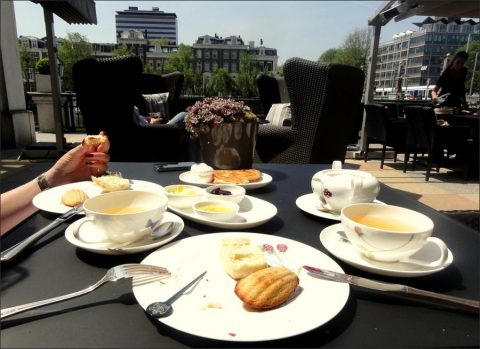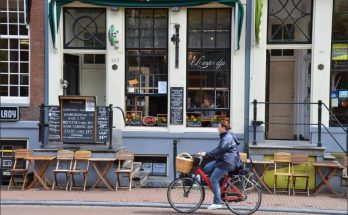Around four hours after lunch, you’ll be ready for the favorite afternoon snack of the Amsterdammers—a raw herring, eaten with a toothpick, from the counter of an open-air stand! While other European cities specialize in hot sausage stands, scattered around town, Amsterdam offers herring stands instead—and after eating your first raw Dutch herring, covered with chopped onions, you’ll understand why. I don’t care how many other species of herring you’ve had—marinated, creamed, pickled, salted—there’s nothing so good as a raw Dutch herring at the famous open air herring stands of Amsterdam.
There are, quite literally, at least a score of herring stands in the central part of Amsterdam, never far from where you may be (ask a resident to point one out). If you’re lucky, you’ll arrive at the stand while a true Dutchman is imbibing the succulent fish. Notice how he grabs it daintily by the tail, holds it high above his mouth, and then devours from the bottom up.
For you, the owner of the stand will cut the skinned and gutted fish into four pieces, give you a wooden pick with which to pick the pieces up, and a bowl of diced onions into which to dip the fish. The best time for herring is in late April and May, when the first catch of “nieuwe haring” comes in. The quality remains high throughout the end of September, but begins to disappear as the winter months set in. Whatever your normal attitude is towards herring, don’t miss an opportunity to taste the Dutch variety—it’s incomparable, a major surprise of amazing Amsterdam.
But now we arrive at the normal, hot-meal-serving restaurants of Amsterdam, to which most people go at night (although they can obviously patronize them at lunchtime, as well). These include restaurants of every nationality and kind—Dutch, French, Spanish, Italian, you name it—but the most unusual, and the ones for which Amsterdam is particularly famed, are the Indonesian and Chinese-Indonesian restaurants serving “rijsttafel.” You can’t pass through Amsterdam without sampling this glorious meal at least once!
Rijsttafel Restaurants
Rijsttafel (literally, “rice table”) is a meal the Dutch discovered during the days of their empire in the Dutch East Indies (now Indonesia); it consists of a central, large dish of rice, surrounded by as many as twenty (that’s right, twenty) other smaller dishes, each including a serving of unusually-prepared, and often fairly spicy, meat or vegetables. One or two at a time, you transfer the contents of the little dishes onto the big pile of rice, eat the rice and its condiments together, and then cool your red-hot throat with big draughts of cold Dutch beer. Not all the dishes are as spicy as I may have implied, however, and the more cautious eaters can put together a rijsttafel meal that is memorable and unique—even though not spicy.
What’s in the little dishes that surround your main bowl of rice? To describe them best, I should describe the best-known of Amsterdam’s rijsttafel restaurants, which is the famed but relatively expensive Bali, 95 Leidsestraat (three short blocks below the Leidse-plein). They serve dish rijsttafel consisting of rice, soup, pork in soya sauce, meat in madera sauce, steamed meat, liver in a special sauce, eggs in sauce, sweet potatoes, bean sprouts, roast pork on sticks, fried bananas, stuffed omelet, vegetables in peanut sauce, cucumber in sour sauce, mixed sour vegetables, fruit in a sweet and sour sauce, and fried grated coconut. Now you know what a rijsttafel is.
No budget tourist, however, need pay as much as the Bali asks, because other restaurants in town—particularly those on the famous Binnen Bantammerstraat—offer a nearly-equivalent rijsttafel for far less money. Simply ask a resident for the location of the Binnen Bantammerstraat, which is a street in the area to the south-east of the railroad station. There you’ll discover, in one block, no fewer than six restaurants serving rijsttafel. Try, in particular, the Azie, 9 Binnen Bantammerstraat; the Kong Hing, 11 Binnen Bantammerstraat; or the Ling Nam, 3 Binnen Bantammerstraat. I prefer the first two, but after having eaten at each at least twice, can’t decide which I like best! Friendly, unpretentious atmosphere—and good rijsttafel—at both.
A slightly-more-expensive version of these multi-item dinners can be had at the tiny, but well-located, Kow Loon, 498 Singel, on the street of the Amsterdam flower market, just 50 yards away from the Nieuw England Department Store and the beginning of the Leidsestraat. Here, a 13-item rijsttafel, 18-items sell for few dollars, and the same 18 items can be served to two persons.
Finally, on the Nieuwendijk (that shopping street that parallels the Damrak), you can have a 12-dish rijsttafel at the somewhat plain, but utterly authentic, Djakarta Restaurant, 89 Nieuwendijk; and a 9-item rijsttafel at the little Ton Sing Restaurant, located where the Nieuwendijk meets the Singel, at 1 Singel. In the “sailors’ district,” at 61 Oude Zijds Voorburgwaal, almost directly across that canal from the Oude Kerk (old church), the Xin Balkans offers one last rijsttafel opportunity: 12 courses, 15 courses for inexpensive price, plus 15% service, and plus the cost of your beverage, of course.
The Normal Dinners
Now we move into the less exotic areas of Dutch cuisine. And because we’ve listed a great many lunchtime spots where you can eat well (the restaurants serving Hollandsche Koffietafels, for instance; the sandwich shops; the Chinese-Indonesian restaurants with their bami goreng and nasi goreng), we can now afford to splurge a bit—surveying, first, the restaurants offering full evening meals.
Drinking
All the normal soft and hard drinks are of course available in Holland, including the incomparable, world-famous Dutch beers. But you’ll also want to try the Dutchman’s favorite aperitif, a gin drink called genever—which all the world knows as “Dutch gin.” It packs a wallop, it needs a little time to get accustomed to, but it grows upon you! And it’s cheap; in a nightclub, therefore, you’d be well advised to keep ordering only genever (chased, perhaps, by beer).
Genever, by the way, is available as either “jonge genever” (young genever) or “oude genever” (old genever); the young kind has less of the distinctive perfumed taste of the other, and is usually more palatable to tourists trying this drink for the first time. Lady tourists, for whom genever may be too strong an item, can try another unusual drink called “Advokaat”—a heavy, spiked, egg-nog-type substance which you eat with a spoon. Prior to World War II, I’m told, Advokaat was about the only drink a proper lady would be caught imbibing; during the war, however, the ladies switched to genever and drink it today in about the same quantity that U. S. ladies devour dry martinis.



